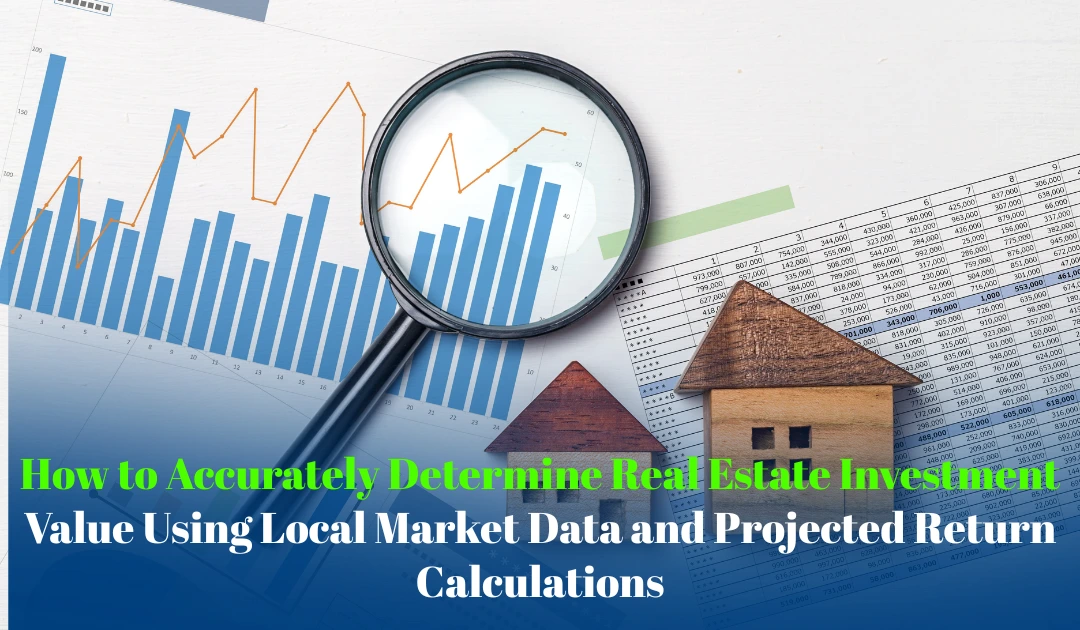Real estate has always been regarded as one of the most stable and rewarding asset classes for investors. However, achieving profitable outcomes in this sector requires far more than simply buying a property and waiting for its value to appreciate. An investor must approach each opportunity with a clear, data-backed understanding of its worth and future potential. Accurately determining real estate investment value is a systematic process that blends local market analysis with projected return calculations. This approach ensures that decisions are grounded in facts rather than speculation.
Understanding the Concept of Real Estate Investment Value
Real estate investment value is not just the current market price of a property. It is a more comprehensive measure that factors in purchase costs, operating expenses, income potential, market demand, and projected appreciation over time. While market price reflects what buyers are willing to pay at a given moment, investment value focuses on what the property is worth to a specific investor based on their financial goals and risk tolerance.
In essence, investment value answers the question: “Given the expected returns and market trends, is this property a good deal for me?”
The Importance of Local Market Data
Local market data forms the backbone of accurate real estate investment evaluation. National or global property trends may provide a broad picture, but real estate is highly localized. A profitable investment in one city might result in poor returns in another, even if both are experiencing economic growth.
Key local market factors to consider include:
- Supply and Demand Trends
Understanding the balance between property availability and buyer demand is essential. If demand exceeds supply, prices and rental rates are likely to rise, boosting investment value. - Neighborhood Analysis
Local amenities, school quality, transportation access, and infrastructure development have a direct impact on property desirability. A property in a well-connected and thriving neighborhood generally commands higher returns. - Historical Price Trends
Analyzing past market performance offers insights into how the area responds to economic changes. This helps in forecasting potential appreciation or depreciation. - Local Economic Indicators
Employment rates, business growth, and new infrastructure projects can significantly influence property values. For instance, the arrival of a major employer can increase housing demand in the surrounding area. - Rental Market Insights
For income-generating properties, understanding average rental rates, vacancy rates, and tenant demand is crucial in estimating cash flow.
Collecting and Interpreting Local Market Data
Accurate evaluation begins with reliable data sources. Investors can gather information from:
- Municipal and government property records
- Local real estate boards and listing services
- Market reports from property consultancies
- Economic development agencies
- On-the-ground research, including speaking with local agents and visiting neighborhoods
After collecting the data, the next step is interpretation. For example, a neighborhood with rising property prices but stagnant rental yields may be more suitable for short-term capital gains rather than long-term rental income. Conversely, an area with stable prices and strong rental demand could be ideal for steady cash flow.
Projected Return Calculations
While market data provides a snapshot of the current scenario, projected return calculations help forecast the future performance of a real estate investment. These calculations involve several metrics:
1. Net Operating Income (NOI)
NOI is calculated by subtracting all operating expenses from the property’s gross income. It excludes mortgage payments and taxes, focusing solely on operational profitability.
Formula:
NOI = Gross Rental Income – Operating Expenses
2. Capitalization Rate (Cap Rate)
Cap rate helps determine the rate of return on an investment property based on its current value.
Formula:
Cap Rate = (NOI ÷ Current Market Value) × 100
A higher cap rate generally indicates a better return, though it may also signal higher risk.
3. Cash-on-Cash Return
This metric compares the property’s annual cash flow to the total cash invested, offering a realistic view of return on actual invested capital.
Formula:
Cash-on-Cash Return = (Annual Cash Flow ÷ Total Cash Invested) × 100
4. Internal Rate of Return (IRR)
IRR accounts for the time value of money, measuring the overall profitability of an investment over its holding period. While more complex to calculate, it provides a comprehensive picture of expected returns.
5. Gross Rent Multiplier (GRM)
GRM compares the property’s price to its gross rental income. While less precise than NOI or cap rate, it’s useful for quick comparisons between properties.
Formula:
GRM = Property Price ÷ Annual Gross Rental Income
Combining Market Data and Return Calculations
The most accurate determination of real estate investment value occurs when local market data is integrated with projected return metrics. For example:
- If market data shows increasing demand and limited supply in a neighborhood, and your return calculations reveal a healthy cap rate and cash-on-cash return, the investment likely has strong potential.
- On the other hand, if the market data is favorable but return calculations show weak profitability due to high expenses or low rental yields, the property might not align with your goals.
Risk Assessment and Sensitivity Analysis
Real estate markets are influenced by various unpredictable factors, from interest rate changes to political policies. Investors should conduct sensitivity analyses to understand how changes in key variables—such as vacancy rates, rental growth, or operating costs—impact returns. This allows for better risk management and informed decision-making.
The Role of Professional Valuation
While investors can conduct their own analysis, professional valuation services offer an added layer of accuracy. Certified valuers use industry-standard methods, such as the sales comparison approach, income approach, and cost approach, to provide a well-documented and unbiased property valuation. Their expertise ensures that all local market nuances are considered, reducing the likelihood of costly mistakes.
Long-Term Strategic Considerations
Real estate investment value should not be determined solely on present-day data. Future growth prospects—such as upcoming infrastructure projects, urban expansion, or zoning changes—can significantly enhance property value over time. Keeping a long-term perspective helps investors avoid being swayed by short-term market fluctuations.
Steps for Accurate Evaluation
To summarize, the process of determining real estate investment value involves:
- Defining Investment Goals – Clarify whether the priority is capital appreciation, rental income, or a balanced approach.
- Gathering Local Market Data – Focus on neighborhood trends, economic indicators, and property-specific details.
- Performing Return Calculations – Use NOI, cap rate, IRR, and other metrics to quantify potential performance.
- Comparing Results with Market Context – Ensure financial metrics align with broader market trends.
- Assessing Risks – Consider both current and potential risks to cash flow and property value.
- Seeking Professional Input – Use professional valuation for high-value or complex investments.
- Making a Data-Driven Decision – Rely on objective analysis rather than emotions or speculation.
Conclusion
Determining real estate investment value is both a science and an art. It requires the discipline to analyze local market data, the technical skill to calculate projected returns, and the foresight to anticipate future changes. By integrating these elements, investors can make confident, well-informed decisions that align with their financial goals. In an ever-changing property market, such a structured and data-driven approach is the key to turning real estate opportunities into lasting wealth.


